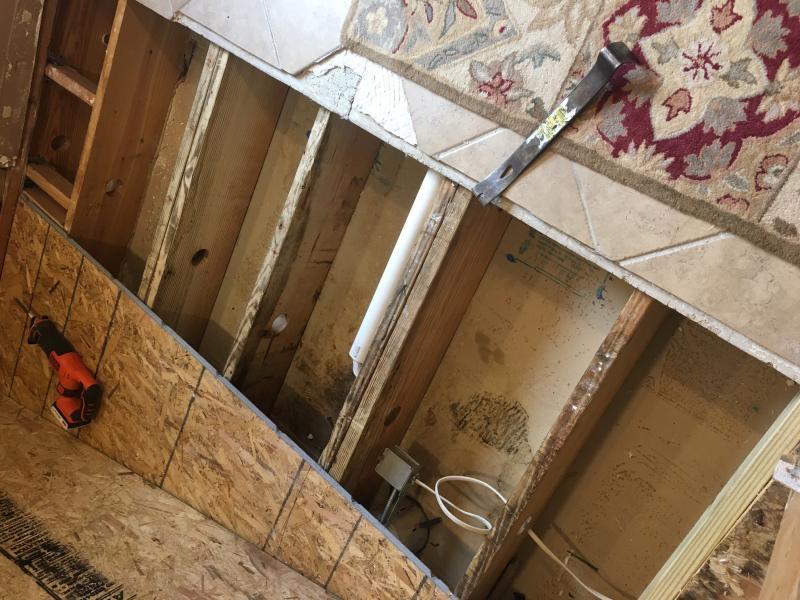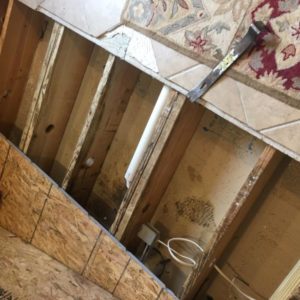Do I need to put insulation between the joists under my shower?
Here’s a picture of my shower I’m re-doing because of a pinhole leak which I didn’t find until the entire shower was gutted. This is in the finished attic of my house, and there was insulation between the joists when I got started but I ripped it out. Is there any reason to put insulation back in these spaces? Originally the attic was unfinished, so that’s why there was insulation in there. Below the joists is one of the bedrooms on the second floor. I’m using a Jacuzzi shower pan on top of the 3/4″ OSB. Would noise be a problem down below? If so, is there something I could use instead of fiberglass insulation to isolate shower sounds from the bedroom below? The entire area is inside the heated/ac area of the house so no need for insulation that I can think of.
Thanks, Frank




















Replies
The only reason you might want thermal insulation there would be because you were installing a really hot heated floor and you were afraid of overheating the bedroom below.
In terms of sound insulation, there are things you can use, but regular thermal insulation would tend to be the least effective. And anything you put there would be relatively wimpy compared to what a good quality shower pan would do. (I assume the Jacuzzi pan is reasonably hefty.) Plus the biggest bump in sound insulation you could manage would probably be to coat the underlayment under the shower with something -- either glued-on vinyl flooring or some sort of tar-like goo. These would exceed the effectiveness of any sort of bat sound insulation in this scenario.
Thanks! I will leave them empty.
Frank
Just be aware that there may be air movement inside those joist bays that you don't expect....with all the hole plumbers and electricians put in joists, air tends to find a path to exterior wall and then you get drafts inside your floors or walls. Check it on a really cold and/or windy day with a wet hand and see if you detect any air movement through the bays....wouldn't want you to put down an expensive tile and then find out its freezing because you now have a wind tunnel underneath.
I've told the story before but my furnace found a path to the outside wall. The colder it got outside the more the furnace would run and the more cold air it would suck into the house....on the plus side we had plenty of fresh air.
A good point! Be sure to plug the joist bays where they run towards the outside wall or where they run any unheated sections of the "attic".
Absolutely true - I actually bought a roll of insulation and plugged the bays where they run to the eaves of the house. There is definitely cold air that comes from that area. You can't see the insulation in this picture because I already put down the subfloor over that area.
Frank
Have a look at ROXUL Safe'n'Sound
I find bathrooms can be noisy places, with running water and hard surfaces. A bathroom above a bedroom could be a problem if it is in use while others are sleeping.
In addition to ensuring that the air movement in the joist bays are closed off to unheated areas ( mentioned by other posters) I would seal up any electrical boxes or wire runs in the floor with acoustic sealant or putty, and use sound insulation batts. I use ROXUL Safe'n'Sound. Reasonably priced, easy to install, and it works. Fiberglass soulnd insulation batts will work as well. These sound insulation batts are much denser than thermal batts.
I like ROXUL better than the fiberglass because they are little stiffer. They a easier to install in awkward places as you can push them into place. In the event of a fire, mineral wool batts do not melt as readily as fiberglass, so provide some increased protection against flame spread.
Roxul??
Is there a difference between Roxul Safe'n'Sound and just plain Roxul?
Obviously there is in the name but in practice is teh sound deadening feature much difference? I believe the price is different.
The Safe'n'Sound is formed differently form the regular thermal. The faces of the Safe'n'Sound are packed harder than the middle, forming stiffer outer layers, softer middle layer.. The regular themal batts are the same density through the thickness. The Safe'nSound is 3" thick, so in a 2x4 stud wall, it leaves an air gap. The thermal stuff completely fills the space.
I don't have any data on what the difference in sound absorption is.